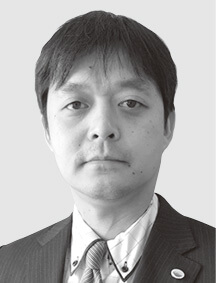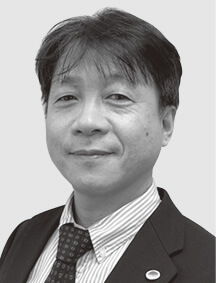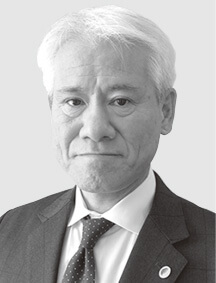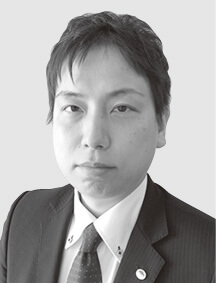Innovation for Next-generation Energy[ⅱ]Distributed Power Supply SolutionsProviding Solutions for the Management Challenges of Power Generation Companies
Highlight
Power generation companies that own thermal power generators have recently been facing increasingly diverse and expanding management challenges as competition intensifies among businesses due to the changing business structure of the power sector. Hitachi is responding by providing various solutions for visualizing these management challenges and implementing concrete measures to resolve them. Specifically, Hitachi is working to support the operation and maintenance activities of power generation companies and improve their management efficiency by providing solutions such as gas turbine (high-temperature) parts management systems, early detection (predictive diagnosis) of boiler tube leaks, and multi-fuel optimization solutions. Hitachi is also seeking to create higher added value by providing all of these solutions after integrating them on a platform.
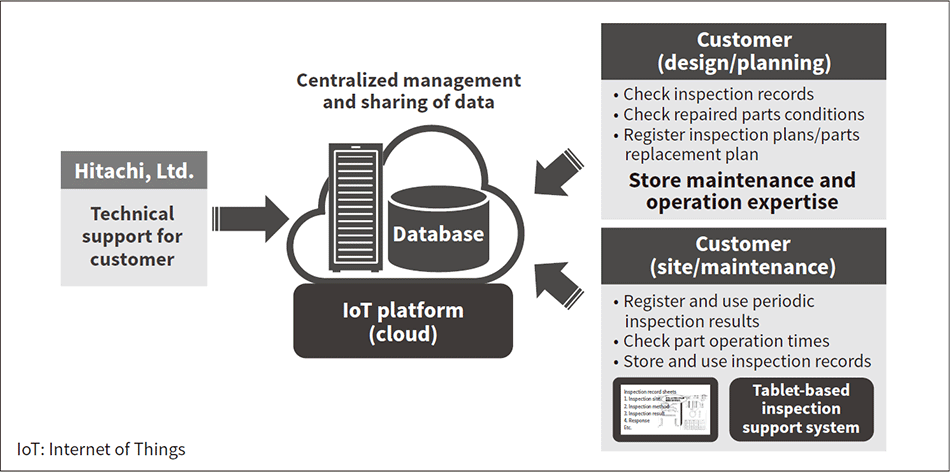
1. Introduction
With recent changes in the business structure of the power sector, power generation companies are facing increasingly diverse management challenges. Hitachi is responding by providing Internet of Things (IoT)-based, high-added-value solutions that solve customer’s challenges. These solutions are designed to support the operation and maintenance (O&M) activities of power generation companies, and are made possible by combining Hitachi’s portfolio of power sector operational technology (OT) and IT expertise that it has cultivated up to now.
This article presents three examples of such solutions — a gas turbine (high-temperature) parts management system, early detection (predictive diagnosis) of boiler tube leaks, and a multi-fuel optimization solution. Also discussed is a platform for power generation companies that offers these solutions after integration, enabling knowledge storage and linking of predictive diagnosis results to facilities. The platform also enables more advanced services with benefits such as faster maintenance and less unplanned downtime.
2. Gas Turbine (High-temperature) Parts Management System
Fig. 1—Conceptual Diagram of Gas Turbine Parts Management System The gas turbine parts management system is constructed on a cloud-based platform. It can be accessed by the customer as well as Hitachi.
The gas turbine parts management system is constructed on a cloud-based platform. It can be accessed by the customer as well as Hitachi.
The high-temperature parts of gas turbines are key components that directly influence performance. Their operation and maintenance require proper management of operation time and inspection records, along with reliable execution of rules-based replacement or rotation.
Hitachi is working to meet these needs by drawing on the expertise in design, manufacturing, maintenance and service it has cultivated up to now to construct a parts management system that manages factors such as high-temperature parts operation times and inventory data for periodically replaced gas turbine parts. The system enables centralized management and sharing of data on a cloud-based IoT platform. It improves the efficiency of inspection and maintenance work, helping reduce gas turbine operation costs (see Figure 1). The system’s main features are as follows.
- Support for periodic inspections
The system can individually manage the operation time of each gas turbine rotor-stator, combustor, and other high-temperature parts that have preplanned operation times. It also creates an operation time management table for each replacement part or parts set, managing the planning and execution of inspection and replacement. When a part’s planned operation time reaches its replacement cycle, the system prompts for replacement at the next periodic inspection, enabling reliable execution of rules-based replacement or rotation. - Support for routine inspections
The customer’s inspection forms can be read into the system and digitalized so that previously paper-based daily inspection procedures can be done from a tablet terminal on which the results can also be recorded. Photos taken from tablets can be inserted into inspection forms for help when creating reports. Storing routine inspection data as digital data also enables checks of time-series numerical data such as equipment pressures and temperatures, along with evaluations drawing on analyses and graphs created from data correlations.
The inventory management function, operation time management function, and tablet inspection function provided by the parts management system are also compatible with equipment other than gas turbines, enabling application across all power generation equipment such as the heat recovery boilers used in gas turbine combined cycle power plants.
3. Predictive Diagnosis Enabling Early Detection of Boiler Tube Leaks
Fig. 2—Overview of Predictive Diagnosis System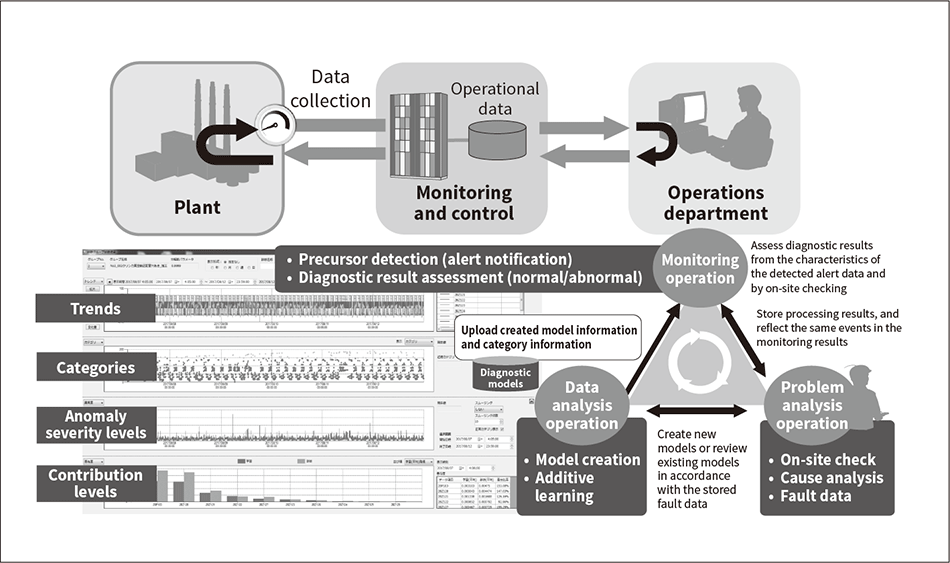 Hitachi has developed artificial intelligence (AI)-based predictive diagnosis technology as a way to improve the reliability of thermal power generation equipment. Hitachi’s predictive diagnosis system automatically classifies and analyzes power plant operation states, enabling real-time detection of the state changes and anomalies that are the precursors of failures.
Hitachi has developed artificial intelligence (AI)-based predictive diagnosis technology as a way to improve the reliability of thermal power generation equipment. Hitachi’s predictive diagnosis system automatically classifies and analyzes power plant operation states, enabling real-time detection of the state changes and anomalies that are the precursors of failures.
Hitachi is developing artificial intelligence (AI)-based predictive diagnosis technology as a way to improve the reliability of power generation equipment.
This technology automatically classifies and analyzes power plant operation states, enabling real-time detection of the state changes and anomalies that are the precursors of failures. Plant data is loaded into the predictive diagnosis system from monitoring and control systems, supporting monitoring and failure analysis operations. The results of the failure analysis operations are used in data analysis operations that create models and provide additional learning, generating feedback for monitoring and failure analysis operations (see Figure 2).
Hitachi has recently conducted joint validation of the predictive diagnosis technology with a domestic power company, drawing on the experience and analysis technologies that it has accumulated in the energy sector in combination with the power company’s power plant operation and maintenance expertise. Adaptive resonance theory (ART) is one of the predictive diagnosis technologies used by Hitachi. By using an ART-based predictive diagnosis system to diagnose boiler tube leaks, Hitachi showed that operators could detect boiler state changes and leak locations 3 to 7 days before plant shutdown operations were performed. Detection was done by assessing anomalies using control equipment alarms or operation management standards (see Figure 3).
Hitachi’s ART-based predictive diagnosis system provides early detection of boiler tube leaks, enabling efficient review of power plant operation plans since response measures and preparations can be handled before the plant is shut down. By identifying boiler tube leak locations, the system also enables appropriate operation monitoring and should decrease plant downtime by enabling earlier investigation of recovery handling measures.
Fig. 3—Example of Anomaly Detection by Predictive Diagnosis System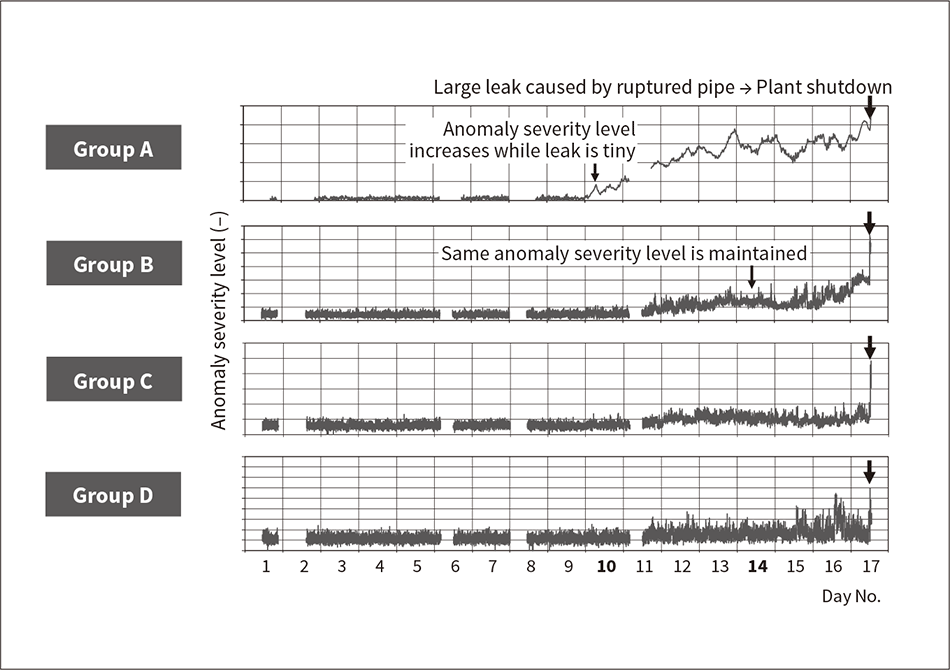 By using the predictive diagnosis system to diagnose boiler tube leaks, Hitachi showed that operators could detect boiler state changes and leak locations 3 to 7 days before plant shutdown operations were performed. Detection was done by assessing anomalies using control equipment alarms and operation management standards.
By using the predictive diagnosis system to diagnose boiler tube leaks, Hitachi showed that operators could detect boiler state changes and leak locations 3 to 7 days before plant shutdown operations were performed. Detection was done by assessing anomalies using control equipment alarms and operation management standards.
4. Multi-fuel Optimization Solution
Fig. 4—Conceptual Diagram of Multi-fuel Optimization Solution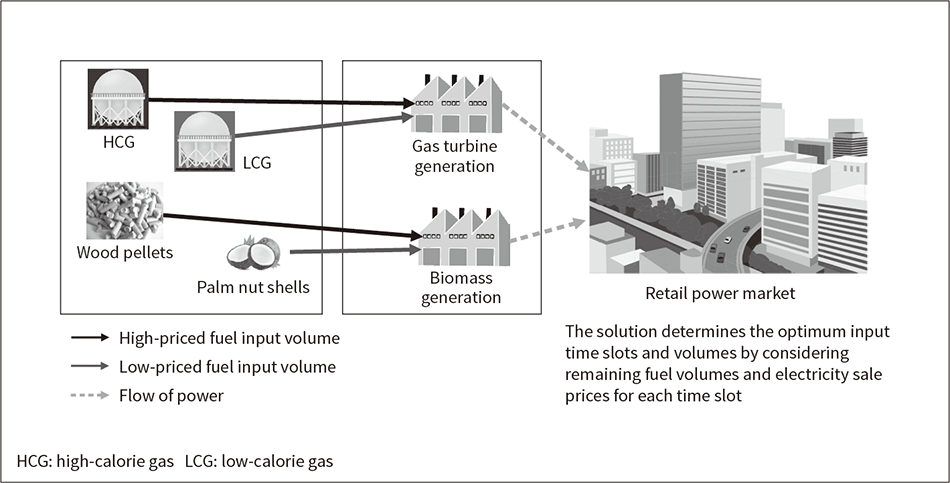 For power plants that use two or more types of fuel, Hitachi’s multi-fuel optimization solution calculates the relative fuel input ratios that will optimize factors such as electricity sale revenue and power generation volume.
For power plants that use two or more types of fuel, Hitachi’s multi-fuel optimization solution calculates the relative fuel input ratios that will optimize factors such as electricity sale revenue and power generation volume.
Hitachi has developed a solution to enable optimum fuel use by power plants that use two or more types of fuel.
These power plants create fuel procurement and consumption plans that specify factors such as fuel storage volumes, generation costs, generation outputs, and electricity sale prices. The plans are often created manually by relying on past experiences, which requires labor and results in inconsistent plan quality.
When addressing these issues, Hitachi realized that power plant value could be improved by finding an optimum solution for maximizing benefits. This optimum solution would consider fuel storage volume and market demand, and be extracted from among factors such as relative fuel usage shares, fuel unit cost, and electricity sale prices that vary by time slot.
The multi-fuel optimization solution can be used to find optimum solutions for fuel input plans designed to minimize fuel consumption volumes and maximize electricity sales revenue under fuel supply and generation volume constraints. Figure 4 illustrates the concept of this solution.
5. Platform for Power Generation Companies
Hitachi is planning to provide solutions to deal with the management challenges of power generation companies on its Lumada platform. These solutions will be released through the two steps described below.
Fig. 5—Conceptual Diagram of Platform for Power Generation Companies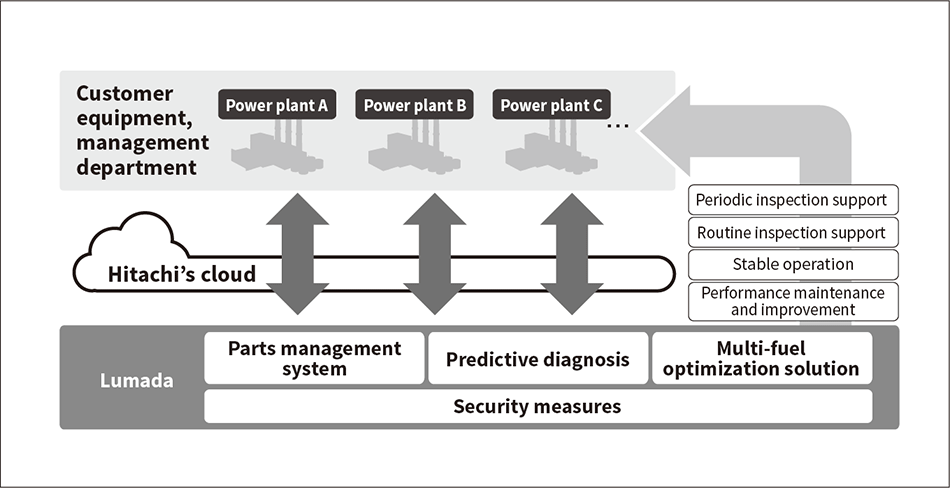 Applications are built on the platform and provided to a large number of customers.
Applications are built on the platform and provided to a large number of customers.
STEP 1
The power plant’s operational data and periodic inspection data will be loaded via Hitachi’s cloud server, and applications will be installed that help the power plant solve the challenges it faces and improve work efficiency.
STEP 2
A platform is constructed that integrates the data stored for individual operations. By providing applications on the platform, knowledge can be stored, and predictive diagnosis results can be linked to plant equipment. Enhanced services with benefits such as faster maintenance and less unplanned downtime can also be created. Hitachi expects to make it possible to share and enhance knowledge by providing this platform to a large number of customers (see Figure 5).
6. Conclusions
With competition among power generation companies expected to become increasingly fierce, they will need to ensure stable equipment operation and further reduce power generation costs. Training young engineers will be another urgent need as growing numbers of experienced engineers leave the workforce.
Hitachi is planning to provide the solutions described in this article on a platform to satisfy customers’ needs through the use of data, and to enable the solutions to be used together to help solve customers’ management challenges and support power generation companies through collaborative creation activities.

